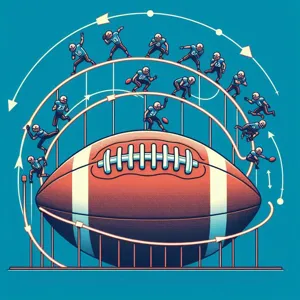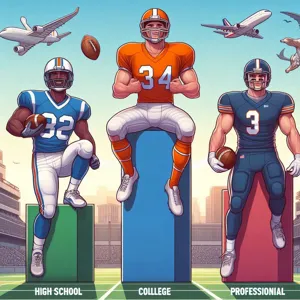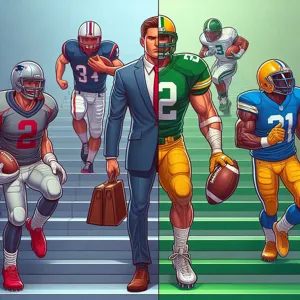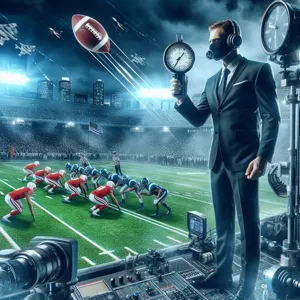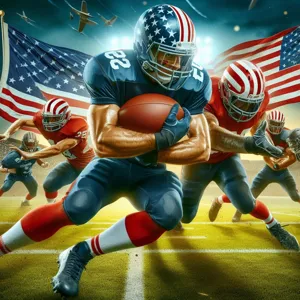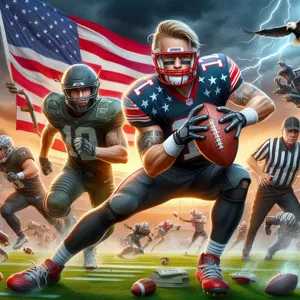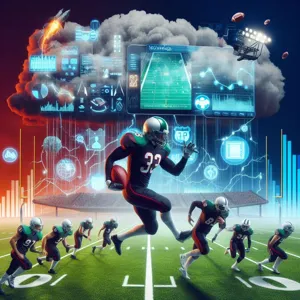As the roar of the crowd fades into the background and the final whistle blows, the landscape of American football stands at a critical juncture, poised between tradition and transformation.
With rising concerns about player safety, the impact of technology, and shifting audience preferences, the sport faces unprecedented challenges that require innovative solutions and a willingness to adapt. The future of American football is not just about preserving the game we love; it’s about navigating the complexities of modern society and embracing change to ensure its longevity. In this blog post, we will delve into the current hurdles facing the sport, explore emerging trends and technologies that could redefine the experience for players and fans alike, and discuss how stakeholders—from leagues and teams to fans and communities—can work together to foster a sustainable and exciting future for American football. Join us as we uncover the pathways forward and envision a new era for this beloved game.
1. Introduction: The Evolution of American Football
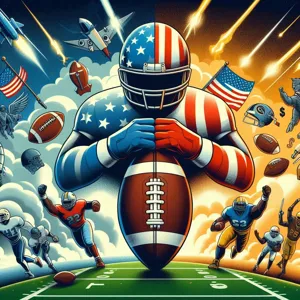
American football, a sport steeped in tradition and passion, has undergone a remarkable evolution since its inception in the late 19th century. Initially played as a rough-and-tumble game with few rules, it has transformed into a highly structured and strategic sport, capturing the hearts of millions across the United States and beyond. From its early days on college campuses, where teams were comprised of students with a shared love for competition, to the billion-dollar industry it is today, American football has continuously adapted to the changing landscape of society.
The introduction of forward passes, the establishment of professional leagues, and the advent of television broadcasts have all played pivotal roles in shaping the game. The National Football League (NFL), which emerged as the preeminent professional league, has not only elevated the sport to new heights but has also woven it into the fabric of American culture. Iconic events like the Super Bowl have become national holidays, drawing in audiences from diverse backgrounds, all eager to partake in the spectacle.
However, as the game has evolved, so too have the challenges it faces. Issues such as player safety, the impact of concussions, and the necessity for inclusivity and diversity are now at the forefront of discussions among players, coaches, and fans alike. As we look toward the future, it is imperative to navigate these challenges while embracing the change that can help preserve the integrity and excitement of American football. The journey ahead will require innovative solutions, a commitment to player well-being, and an openness to new ideas that honor the rich history of the sport while paving the way for a vibrant future.
2. Current Challenges Facing the Sport
As we look toward the future of American football, it’s crucial to first understand the myriad challenges currently confronting the sport. These hurdles not only impact the game at a professional level but also resonate throughout youth leagues and community programs across the nation.
One major challenge is the growing concern over player safety, particularly regarding head injuries and concussions. With numerous studies linking football to long-term cognitive issues, parents are increasingly hesitant to allow their children to participate in the sport. This fear has led to declining youth participation rates, posing a threat to the sport’s future talent pool. As organizations like the NFL work to implement stricter safety protocols, the question remains: how can they effectively balance the physical nature of the game with the need to protect its players?
Another pressing issue is the ongoing debate over the sport’s cultural relevance and the social justice movements that have permeated the football landscape. Players and coaches are using their platforms to advocate for change, sparking both support and backlash from fans and sponsors alike. The intersection of sports and politics is more pronounced than ever, leaving football organizations to navigate these complex waters while maintaining a unified fanbase.
Additionally, the financial landscape of the sport is shifting. As streaming services vie for broadcasting rights and alternative entertainment options compete for viewers’ attention, traditional revenue streams are being challenged. Teams must adapt to this changing environment, seeking innovative ways to engage fans and monetize their brands while ensuring the game remains accessible to all.
Finally, we cannot overlook the impact of climate change on the sport. Extreme weather events, such as heatwaves or severe storms, can disrupt schedules, affect player performance, and even endanger the safety of fans attending games. As the climate crisis intensifies, the sport must explore sustainable practices and rethink how it operates to mitigate its environmental impact.
Understanding these challenges is crucial for anyone involved in the sport—be it players, coaches, fans, or administrators. By addressing these issues head-on, American football can not only preserve its rich legacy but also evolve to meet the demands of a changing world.
3. The Impact of Safety Concerns on Player Participation

As the landscape of American football evolves, one of the most pressing issues facing the sport is the growing concern over player safety. In recent years, the conversation around concussions and long-term brain injuries has intensified, leading to increased scrutiny from parents, coaches, and medical professionals. This heightened awareness has sparked a critical question: how will these safety concerns impact player participation at all levels of the game?
The statistics are telling; studies have shown a notable decrease in youth football enrollment across the country. Parents, understandably protective of their children, are weighing the risks associated with football against other sports. As stories of professional players grappling with the effects of past injuries flood the media, more families are opting for sports perceived as safer alternatives, such as soccer or basketball. This shift not only threatens the future of youth leagues but also has ripple effects on high school and collegiate teams, where a steady influx of talent is essential for maintaining competitive programs.
In response to these concerns, football organizations are actively implementing measures designed to improve player safety. Rule changes aimed at reducing head injuries, enhanced helmet technology, and strict protocols for monitoring player health during practices and games are becoming commonplace. However, while these initiatives are vital for mitigating risks, they must also be effectively communicated to parents and young athletes to restore confidence in the sport.
Moreover, the future of American football lies in its ability to adapt and evolve. Embracing innovative training methods, increasing transparency about player health, and fostering open dialogues within communities can help bridge the gap between safety concerns and participation levels. By demonstrating a commitment to player welfare, football can strive to retain its status as America’s pastime while ensuring that future generations can enjoy the game in a safer environment. Ultimately, navigating these challenges is not just about preserving the sport; it’s about fostering a culture that prioritizes health and safety without compromising the passion and excitement that football brings to millions.
4. Addressing Concussions and Player Health
The issue of concussions and player health has emerged as one of the most pressing challenges facing American football today. As awareness of the long-term effects of head injuries has grown, so too has the scrutiny on how the sport protects its athletes. In recent years, the NFL and other football organizations have made strides to enhance player safety, implementing stricter concussion protocols and investing in advanced helmet technology. However, there is still much work to be done to ensure that players are safeguarded both on and off the field.
One of the key components in addressing concussions is education—coaches, players, and parents must be well-informed about the risks and symptoms associated with head injuries. Training programs that focus on proper tackling techniques and awareness of head impact can significantly reduce the likelihood of concussions. Furthermore, fostering a culture that prioritizes health over a “tough it out” mentality is crucial; players should feel empowered to report injuries without fear of losing their position or reputation.
Off the field, support systems for players are essential. This includes access to mental health resources, rehabilitation programs, and initiatives that help former players navigate the challenges associated with post-career life. As the conversation around player health continues to evolve, it’s imperative that leagues, teams, and fans work together to advocate for comprehensive care and policy changes that prioritize the well-being of athletes.
Ultimately, addressing concussions and player health is not just about reacting to injuries but proactively creating an environment that values the longevity and quality of life of every player. By embracing this change, American football can evolve into a safer, more sustainable sport that honors its athletes and retains its passionate fanbase for generations to come.
5. The Role of Technology in Enhancing the Game
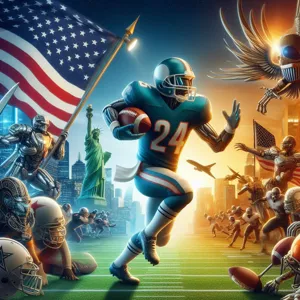
In the rapidly evolving landscape of American football, technology plays a pivotal role in enhancing both the game itself and the overall experience for fans, players, and coaches alike. From advanced analytics to immersive fan engagement, the integration of cutting-edge technology is reshaping how the sport is played and perceived.
One of the most significant advancements has been the use of data analytics. Teams are now equipped with sophisticated software that analyzes player performance and game strategies in real time. Coaches can utilize this data to make informed decisions, adapt their tactics on the fly, and optimize training regimens. For instance, wearable technology, such as GPS trackers and heart rate monitors, allows coaching staff to gather detailed insights into player health and performance metrics, ensuring that athletes can perform at their peak while minimizing the risk of injury.
Moreover, video analysis tools have revolutionized the way teams prepare for games. High-definition cameras capture every moment on the field, allowing coaches and players to dissect plays and identify areas for improvement. This level of scrutiny not only enhances team performance but also fosters a deeper understanding of the game among players, enabling them to make quicker decisions under pressure.
On the fan engagement front, technology has opened up new avenues for interaction and entertainment. Virtual reality (VR) and augmented reality (AR) experiences are transforming how fans enjoy the game. Imagine stepping into a VR simulation of a live game, feeling the excitement of being on the sidelines, or using AR to access real-time statistics and player information simply by pointing your smartphone at the field. These innovations create a more immersive experience, drawing fans closer to the action and deepening their emotional connection to their favorite teams.
In addition, social media platforms and streaming services have broadened the audience for American football, allowing fans to engage with the sport anytime, anywhere. Live-tweeting during games, sharing highlights on TikTok, and participating in online discussions keeps fans connected and invested in the game, regardless of their physical location.
As we look to the future, embracing technology will be crucial in addressing the challenges facing American football, from player safety to fan engagement. By leveraging the latest innovations, the sport can not only enhance the quality of the game but also ensure its relevance in an increasingly digital world. The marriage of technology and American football promises an exciting evolution, one that will keep fans on the edge of their seats and players at the top of their game.
6. Evolving Fan Engagement in the Digital Age
In the digital age, the landscape of fan engagement in American football has transformed dramatically, presenting both challenges and opportunities for teams and leagues alike. Gone are the days when fans relied solely on television broadcasts or game-day experiences to connect with their favorite teams. Today, technology has paved the way for a multifaceted approach to engaging with fans, making it essential for organizations to adapt or risk being left behind.
Social media platforms like Twitter, Instagram, and TikTok have become vital channels for real-time interaction, allowing teams to engage with fans instantaneously. Whether it’s sharing behind-the-scenes content, live game updates, or exclusive interviews with players, these platforms have created a more personal connection between fans and their teams. The immediacy of social media not only fosters a sense of community but also provides fans the opportunity to express their thoughts and feelings in real time, generating a dynamic dialogue that enhances their overall experience.
Moreover, the rise of mobile applications has revolutionized how fans consume content. Dedicated apps allow fans to access game highlights, player stats, and live commentary directly from their smartphones, making it easier than ever to stay connected, even when they can’t be in the stadium. Teams are now leveraging augmented reality (AR) and virtual reality (VR) experiences to create immersive fan experiences, from virtual stadium tours to interactive player meet-and-greets, enhancing the thrill of being a fan beyond the physical confines of the game.
However, with these advancements come challenges. The digital landscape is crowded, and capturing the attention of fans amidst a sea of distractions requires creativity and innovation. Teams must be proactive in understanding their audience’s preferences and behaviors, utilizing data analytics to tailor content that resonates with fans on a personal level. Personalization is key; fans are more likely to engage with content that feels relevant to them, whether it’s targeted promotions, interactive polls, or exclusive access to team events.
As American football navigates this evolving digital landscape, embracing change is paramount. By leveraging technology to enhance fan engagement, teams can cultivate a loyal fanbase, ensuring that the love for the game continues to thrive in this fast-paced, digital world. The future of football lies not only in the games played on the field but also in the connections forged off it, as teams embrace the ever-evolving ways to keep their fans engaged and invested.
7. Challenges of Maintaining Traditional Values
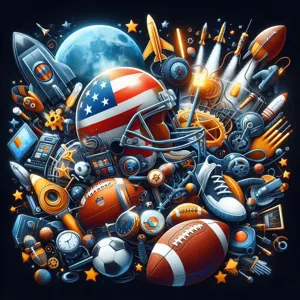
As American football continues to evolve, one of the most pressing challenges lies in balancing the sport’s rich traditional values with the demands of a changing landscape. The heart of football is steeped in a storied history—tactics honed over decades, the physicality that defines the game, and the deep-rooted camaraderie among players and fans alike. However, as societal norms shift and the conversation around player safety intensifies, maintaining these traditions becomes a delicate dance.
The traditional image of football has often celebrated toughness and aggression, qualities that have long been revered in the sport. Yet, with growing awareness of the long-term effects of concussions and other injuries, there is a palpable tension between preserving the hard-hitting nature of the game and prioritizing player health. This challenge is further compounded by the rise of youth sports, where parents are increasingly scrutinizing the safety of football for their children, leading to a decline in participation at the grassroots level.
Moreover, the sport faces scrutiny regarding its inclusivity and diversity. As conversations around social justice and representation gain momentum, the traditional culture of football must adapt to be more welcoming and supportive of all players, regardless of their background. This shift is essential not only for the integrity of the game but for its continued relevance in an ever-evolving society.
Navigating these challenges requires a commitment to open dialogue among stakeholders—players, coaches, fans, and league officials—about what the future of football should look like. By embracing change while honoring the core principles that have defined the sport, American football can continue to thrive amid the pressures of modernization. The key will be finding a balance that respects tradition while fostering an environment that is safe, inclusive, and adaptable to future generations of players and fans.
8. The Future of Youth Football Programs
As the landscape of American football evolves, youth football programs stand at a pivotal crossroads. With growing concerns around player safety, particularly in relation to concussions and long-term health issues, the future of these programs hinges on a delicate balance between preserving the essence of the game and prioritizing the well-being of young athletes.
In recent years, parents and guardians have become more cautious about enrolling their children in contact sports, prompting many leagues to explore alternative approaches. This has led to an increase in flag football and non-contact variants, which not only minimize the risk of injury but also help children develop fundamental skills such as teamwork, agility, and strategic thinking without the physical toll of traditional tackle football. These adaptations may well pave the way for a new generation of players who are better prepared for the rigors of the game.
Moreover, youth football programs are increasingly embracing technology and advanced training methods. From using wearable devices that monitor player health to integrating virtual coaching apps, these innovations are transforming the way young athletes train and learn. Coaches are now equipped with data-driven insights that can inform training regimens and improve player performance, ensuring that young athletes not only develop their skills but also remain safe while doing so.
Community involvement and grassroots initiatives are also crucial in shaping the future of youth football. Programs that promote inclusivity, diversity, and accessibility can help attract a wider range of participants, fostering a love for the game that transcends socioeconomic barriers. By prioritizing mentorship and community engagement, leagues can cultivate a supportive environment that encourages young players to thrive both on and off the field.
As we look ahead, the future of youth football programs will undoubtedly be shaped by these emerging trends and challenges. By adapting to the changing landscape, embracing innovation, and focusing on safety and inclusivity, youth football can continue to be a vital part of American sports culture, inspiring the next generation of athletes to play with passion, integrity, and respect for the game.
9. Embracing Diversity and Inclusion in American Football
In the ever-evolving landscape of American football, embracing diversity and inclusion is not just a moral imperative; it’s a strategic advantage that can drive innovation, enhance team performance, and expand the sport’s reach. As the demographics of both players and fans continue to diversify, the need for football organizations—ranging from youth leagues to the NFL—to reflect this changing landscape has never been more critical.
Diversity in football means more than just racial and ethnic representation; it encompasses gender, socioeconomic backgrounds, and different abilities. By fostering an inclusive environment, teams can attract a broader range of talent on and off the field, leading to a richer pool of perspectives and ideas. This diversity can catalyze creative strategies, improve problem-solving, and ultimately contribute to better on-field performance.
Moreover, inclusivity plays a vital role in enhancing the fan experience. By creating welcoming spaces for all fans, teams can cultivate a more passionate and engaged fan base. From marketing campaigns that celebrate various cultures to outreach programs that connect with underrepresented communities, embracing diversity will not only build goodwill but also foster loyalty among fans who feel seen and valued.
The NFL, for instance, has made strides in initiatives like the “Rooney Rule,” which aims to increase minority representation in coaching and management positions. While progress has been made, there is still much work to be done. By prioritizing diversity at all levels, from hiring practices to community engagement, football organizations can create a more equitable landscape that reflects the society it entertains.
As American football looks to the future, embracing diversity and inclusion will be essential in navigating the challenges ahead. By championing diverse voices and experiences, the sport can not only thrive but also become a powerful force for unity and progress, inspiring future generations both on and off the field.
10. Innovations in Coaching and Training Methods
As the landscape of American football evolves, so too do the coaching and training methods that shape the athletes of tomorrow. Innovations in this arena are not just enhancing performance on the field; they are redefining the very approach to the game itself.
Technology has become an integral part of coaching, allowing for real-time analytics and performance tracking that were once unimaginable. Wearable devices and sophisticated software can monitor players’ vital signs, movement patterns, and even their mental fatigue levels. Coaches can use this data to tailor training regimens to each player’s specific needs, optimizing their development and reducing the risk of injury. Imagine a future where every practice is customized based on precise metrics, creating a more effective and personalized approach to training.
Furthermore, virtual reality (VR) and augmented reality (AR) are making waves in the coaching sphere. These immersive technologies help players visualize plays, understand game tactics, and simulate high-pressure situations without the physical toll of actual practice. By stepping into a virtual environment, athletes can hone their skills and decision-making abilities, allowing for a more profound understanding of the game. As these technologies continue to advance, they are likely to become staples in football training programs across the nation.
Additionally, the rise of data analytics has led to a shift in coaching philosophy. Coaches are now more equipped than ever to make informed decisions based on empirical evidence rather than intuition alone. This data-driven approach not only enhances game strategies but also aids in player recruitment and talent development, ensuring that teams are built for success both on and off the field.
In embracing these innovations, coaches and trainers are not merely adapting to change; they are leading the charge toward a more dynamic and scientifically grounded approach to American football. As the game progresses, the fusion of traditional techniques with cutting-edge technology will undoubtedly pave the way for a new era of excellence, ensuring that the future of American football is as exciting as it is unpredictable.
11. The Influence of Social Media on the Sport
In an era where social media reigns supreme, its influence on American football has become undeniable and transformative. Platforms like Twitter, Instagram, TikTok, and Facebook have not only changed how fans engage with the game but have also reshaped the sport’s marketing, branding, and communication strategies. Teams, players, and leagues leverage these platforms to connect with their audiences on a personal level, breaking down barriers that once separated athletes from their fans.
Social media allows for real-time interaction, giving fans a front-row seat to behind-the-scenes moments, training sessions, and even personal lives of their favorite players. This direct line of communication fosters a sense of intimacy and loyalty, as fans feel more invested in the journeys of their beloved teams and athletes. Viral moments, whether they be a jaw-dropping play, a heartfelt charity initiative, or a humorous off-field incident, can catapult a player or team into the stratosphere of popularity overnight.
Moreover, the power of social media extends beyond mere engagement; it has become a vital tool for advocacy and social change within the sport. Players are using their platforms to raise awareness about important social issues, inspiring a new generation of fans to not only support their teams but also to stand up for causes they believe in. The ability to quickly mobilize support or spread messages amplifies the impact athletes can have on society at large.
However, this newfound influence comes with its challenges. The instant nature of social media can lead to rapid dissemination of misinformation, as well as pressure on players to maintain their public personas. The potential for negative commentary and cyberbullying is a reality that many athletes must navigate, adding another layer of complexity to their careers.
As American football continues to evolve, embracing the influence of social media while managing its pitfalls will be crucial. The sport stands at a crossroads, where it must balance tradition with modernity, ensuring that it remains relevant and engaging to both new and seasoned fans. By harnessing the potential of social media thoughtfully, American football can foster deeper connections with its audience, paving the way for a vibrant and inclusive future.
12. Navigating Economic Challenges: Sponsorship and Revenue
In the ever-evolving landscape of American football, navigating economic challenges has become a critical focus for teams and organizations alike. As the sport grapples with shifts in viewership, changing consumer behaviors, and the lingering impacts of global economic fluctuations, the need for innovative revenue streams and robust sponsorship deals has never been more pronounced.
Sponsorship has traditionally served as a lifeblood for football franchises, providing essential funding to support everything from player salaries to facility upgrades. However, as brands increasingly seek to align with values-driven consumers, teams must adapt their sponsorship strategies to resonate with a more discerning audience. This means not only securing larger deals with major corporations but also fostering relationships with local businesses that reflect the community’s spirit and values.
To navigate these economic challenges effectively, teams are exploring diverse partnerships that extend beyond traditional boundaries. Interactive experiences, such as fan engagement events and personalized merchandise, are becoming pivotal in enhancing sponsorship value. With digital platforms taking center stage, teams can tap into social media and streaming services to create targeted advertising campaigns that engage fans in real-time, driving both visibility and revenue.
Moreover, the introduction of innovative technologies—like augmented reality (AR) and virtual reality (VR)—offers exciting opportunities for teams to enhance fan experiences and attract new sponsorships. By creating immersive environments that allow fans to engage with their favorite teams in ways previously unimaginable, football organizations can increase their appeal to potential sponsors looking for fresh avenues to connect with audiences.
Ultimately, the future of American football hinges on the ability to adapt to these economic challenges while embracing change. By reimagining sponsorship structures and leveraging new technologies, teams can not only sustain their financial viability but also enhance the overall fan experience, ensuring that American football remains a beloved staple of American culture for generations to come.
13. The Future of American Football: Trends to Watch
As American football enters a new era, several key trends are emerging that could redefine the game both on and off the field. Understanding these trends is crucial for fans, players, and stakeholders alike, as they navigate the evolving landscape of this beloved sport.
One significant trend is the increasing emphasis on player safety. In recent years, the NFL and college football have made strides to implement stricter rules regarding hits and tackles to protect players from the long-term effects of concussions and other injuries. This focus on safety is likely to intensify, with more innovative technologies, such as advanced helmets and real-time injury assessments, being integrated into the game. As players become more aware of the risks involved, recruitment and training practices may also shift, prioritizing not just skill but also safety protocols.
Another noteworthy trend is the rise of data analytics in football strategy. Coaches and teams are harnessing the power of big data to analyze player performance, game strategies, and even fan engagement. From predictive analytics that inform play-calling decisions to performance metrics that guide training regimens, the data revolution is changing how teams operate. As technology continues to evolve, expect to see even more sophisticated tools and techniques that will reshape game strategies, making football more dynamic and unpredictable.
Moreover, the influence of social media and digital platforms is becoming increasingly pronounced. Fans are no longer passive spectators; they engage with the game in real-time through social media channels, sharing their opinions and experiences. Teams are leveraging this trend by enhancing their online presence and creating interactive content that keeps fans engaged year-round. This shift not only fosters a deeper connection between teams and their supporters but also opens new avenues for marketing and sponsorship opportunities.
Finally, the globalization of American football cannot be overlooked. With the NFL hosting games in international markets and a growing fan base beyond U.S. borders, the sport is poised for expansion. This trend could lead to increased participation at the grassroots level in various countries, creating a more diverse and inclusive football landscape. As more international players enter the league, the game could evolve in exciting new directions, blending styles and strategies from around the world.
In summary, the future of American football is marked by a commitment to player safety, the integration of advanced analytics, the evolution of fan engagement through digital platforms, and the sport’s growing global reach. By keeping an eye on these trends, stakeholders can better prepare for the challenges and opportunities that lie ahead, ensuring that American football continues to thrive in the years to come.
14. Case Studies: Successful Adaptations in Other Sports
In exploring the future of American football, it’s crucial to look at successful adaptations in other sports that have faced their own set of challenges. These case studies provide valuable insights and potential pathways that could be beneficial for football as it navigates its evolving landscape.
One prominent example is the National Basketball Association (NBA), which has effectively embraced change to enhance both player safety and the fan experience. Following concerns about player injuries, particularly concussions, the league implemented strict guidelines regarding head injuries and recovery protocols. Additionally, they adjusted the game rules to promote a faster pace and higher scoring, appealing to younger audiences. This shift not only revitalized the sport but also increased viewership and fan engagement, showcasing the importance of adapting to the needs and preferences of both players and spectators.
Similarly, Major League Baseball (MLB) has faced its own challenges regarding pace of play and declining viewership among younger fans. To combat this, the league introduced several innovative measures, such as the implementation of a pitch clock and limited mound visits. These changes have helped streamline the game, making it more dynamic and accessible for new audiences. By actively seeking feedback and experimenting with rules, MLB has demonstrated a willingness to evolve while preserving the essence of the sport.
Another example can be found in soccer, where leagues worldwide have implemented video assistant referees (VAR) to enhance the accuracy of officiating. While initially met with skepticism, VAR has gradually gained acceptance, ultimately improving trust in the system and the overall quality of the game. This willingness to embrace technology illustrates how sports can adapt to modern expectations and improve the experience for players and fans alike.
These case studies highlight that successful adaptation is not merely about addressing immediate challenges but also about anticipating future trends and evolving with them. As American football faces its own set of hurdles—such as player safety concerns, the need for more inclusivity, and competition from alternative entertainment options—looking to sports like basketball, baseball, and soccer can offer crucial lessons. By learning from these successful adaptations, American football can forge a path that balances tradition with innovation, ensuring its relevance and vibrancy in the years to come.
15. Conclusion: Charting a New Course for American Football
As we stand at the crossroads of tradition and innovation, the future of American football beckons with both challenges and opportunities. The sport, with its rich history and deep-rooted cultural significance, must adapt to an evolving landscape that demands greater inclusivity, safety, and relevance. The calls for change are not merely whispers; they are resounding messages from players, coaches, fans, and advocates who envision a game that honors its past while boldly stepping into the future.
To chart this new course, stakeholders across all levels—from the NFL to youth leagues—must engage in open dialogues, prioritizing the health and well-being of athletes above all else. This includes embracing advancements in technology that can enhance player safety, refining training techniques, and implementing more robust concussion protocols. Moreover, the sport must continue to foster diversity and inclusion, ensuring that the voices of all players are heard and valued.
In addition, as fan engagement evolves in the digital age, teams must harness the power of technology to create richer, more interactive experiences that resonate with a new generation of supporters. From augmented reality to personalized content, the possibilities are endless. The key lies in understanding and anticipating the desires of fans while maintaining the core values that make football so beloved.
Ultimately, the future of American football is not a predetermined path but a canvas awaiting the brushstrokes of innovation, resilience, and collaboration. By embracing change and working collectively towards common goals, we can ensure that this iconic sport remains a vibrant and integral part of American culture for generations to come. As we look ahead, let us celebrate the spirit of the game while committing to its evolution, forging a legacy that honors its past while inspiring a brighter future.
As we conclude our exploration of the future of American football, it’s clear that the sport stands at a pivotal crossroads. The challenges we face—from player safety concerns to evolving audience preferences—demand innovative solutions and a willingness to embrace change. By prioritizing player welfare, enhancing fan engagement through technology, and fostering inclusivity at all levels, we can ensure that football not only survives but thrives in the years to come. The passion for the game remains unwavering, and with a collective effort from players, coaches, organizations, and fans alike, we can navigate these challenges successfully. Let’s champion a future where American football continues to captivate hearts and inspire generations, ensuring that the spirit of the game endures for years to come. Thank you for joining us on this journey into the future of our beloved sport!






